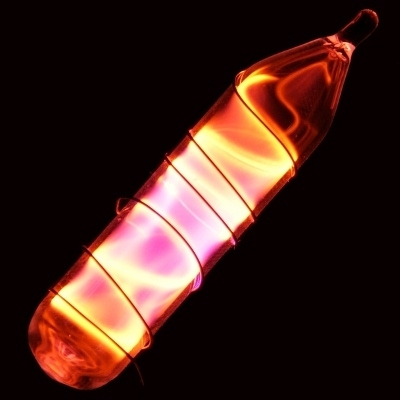Neon
From The Encyclopedia of Earth
Named from the Greek word meaning "new", neon is a colorless, odorless gas. It is nearly inert towards all other elements and chemicals. The primary use of neon is the colored lights that take their name from the element. A moderate electric current will cause even low amounts of neon to glow a bright orange-red. Neon also is used in TV tubes, lasers and as a refrigerant.
Neon was discovered in 1898 by Sir William Ramsay and Morris Travers.
| Previous Element: Flourine Next Element: Sodium |
| |
| Physical Properties | ||
|---|---|---|
| Color | colorless | |
| Phase at Room Temp. | gas | |
| Density (g/cm3) | 0.0009 | |
| Hardness (Mohs) | --- | |
|
Melting Point (K) |
24.53 | |
|
Boiling Point (K) |
27.1 | |
| Heat of Fusion (kJ/mol) | 0.3 | |
| Heat of Vaporization (kJ/mol) | 1.7 | |
| Heat of Atomization (kJ/mol) | 0 | |
| Thermal Conductivity (J/m sec K) | 0.05 | |
| Electrical Conductivity (1/mohm cm) | 0 | |
| Source | air | |
| Atomic Properties | ||
| Electron Configuration | [He]2s22p6 | |
|
Number of Isotopes |
3 | |
| Electron Affinity (kJ/mol) | 141 | |
| First Ionization Energy (kJ/mol) | 2080.6 | |
| Second Ionization Energy (kJ/mol) | 3952.2 | |
| Third Ionization Energy (kJ/mol) | 6121.9 | |
| Electronegativity | Not defined (Pauling Scale) | |
| Polarizability (Å3) | 0.396 | |
| Atomic Weight | 20.18 | |
| Atomic Volume (cm3/mol) | 16.7 | |
| Ionic Radius2- (pm) | --- | |
| Ionic Radius1- (pm) | --- | |
| Atomic Radius (pm) | 71 | |
| Ionic Radius1+ (pm) | --- | |
| Ionic Radius2+ (pm) | --- | |
| Ionic Radius3+ (pm) | --- | |
| Common Oxidation Numbers | --- | |
| Other Oxid. Numbers | --- | |
| Abundance | ||
| In Earth's Crust (mg/kg) | 5×10-3 | |
| In Earth's Ocean (mg/L) | 1.2×10-4 | |
| In Human Body (%) | 0% | |
| Regulatory / Health | ||
| CAS Number | 7440-01-9 | |
| OSHA Permissible Exposure Limit (PEL) | No limits | |
| OSHA PEL Vacated 1989 | No limits | |
|
NIOSH Recommended Exposure Limit (REL) |
No limits | |
|
Sources: |
||
